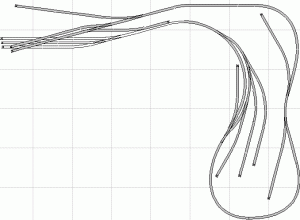To Bill (K)....
I used the NMRA turnout drawings and guidelines as a general reference, and for the frog angle just used the "rule" that a #4 turnout diverges 1 inch in 4, a #6, 1 inch in 6, etc. But I plan to hand lay the turnouts on my next layout. (I'm in a fairly long period "between" layouts just now.) If I was planning to use purchased turnouts, I'd buy a sample of each and take my measurements directly off them. Somehow each manufacturer seems to get different angles from "1 in 6"!
I've seen advice to people who hand lay turnouts to just "build them to fit," but unless you are fitting them to standards, you're liable to wind up with #3's which I doubt would work very well unless you're modeling trolleys.
To Kettlestack....
I've never used any of the AutoCAD products for track layout, but having used A'CAD and A'CAD Light for general drafting, I cannot imagine what you mean by construction lines. A really good CAD program (I'd rate A'CAD as a fair CAD program) is really the ONLY way to effectively create a dimensionally accurate "engineering" drawing, other than drawing it by hand. The rub is that good CAD is expensive, as is a good plotter that can output the drawings on large size paper (24x36 or larger). And beyond that, they can take a whole lot of time and commitment to learn to use. I'm fortunate in that as a design engineer (now retired) I learned to use them and aquired the equipment professionally.
I downloaded the Atlas software out of curiosity, and gave it a try. But it is so limited and so limiting in what it does (at least compared to professional CAD) that I gave up on it. The price is right of course, but I suspect it would take as long to learn as real CAD, so my suggestion is to find someone with AutoCAD (or if you're REALLY lucky, VersaCAD) and "borrow" it, if you really want CAD.
Or, if the time to learn CAD is impractical, the model railroader could buy a drawing board, T square, and some triangles, and teach him/herself to draw. More years ago than I like to remember --- before I had any design or engineering training --- I did just that, and even wound up designing a fire station for a city in Oregon that WAS built, and IS in use today. (Ah, the recklessness of youth. Now I shudder to think of all I DID NOT know then!)
Bill Stone


